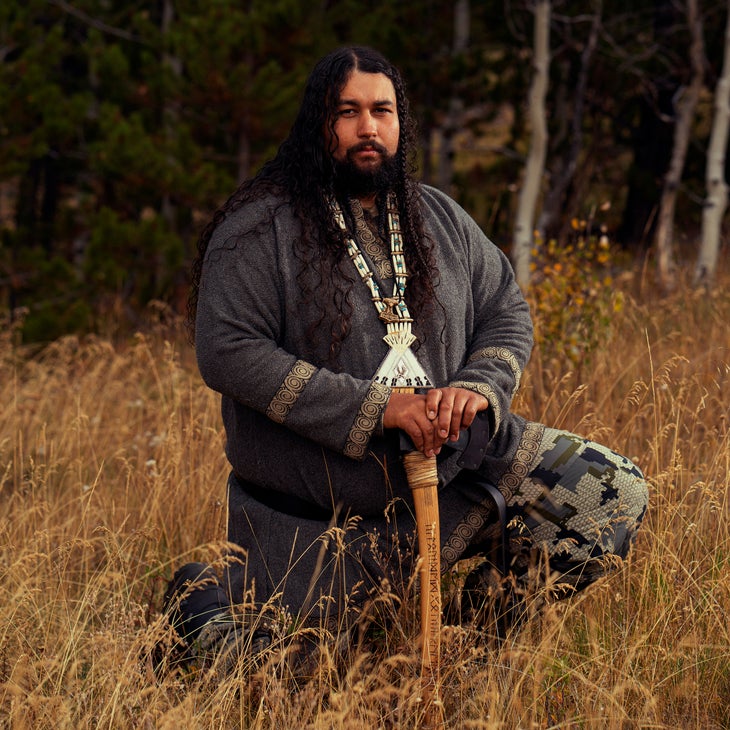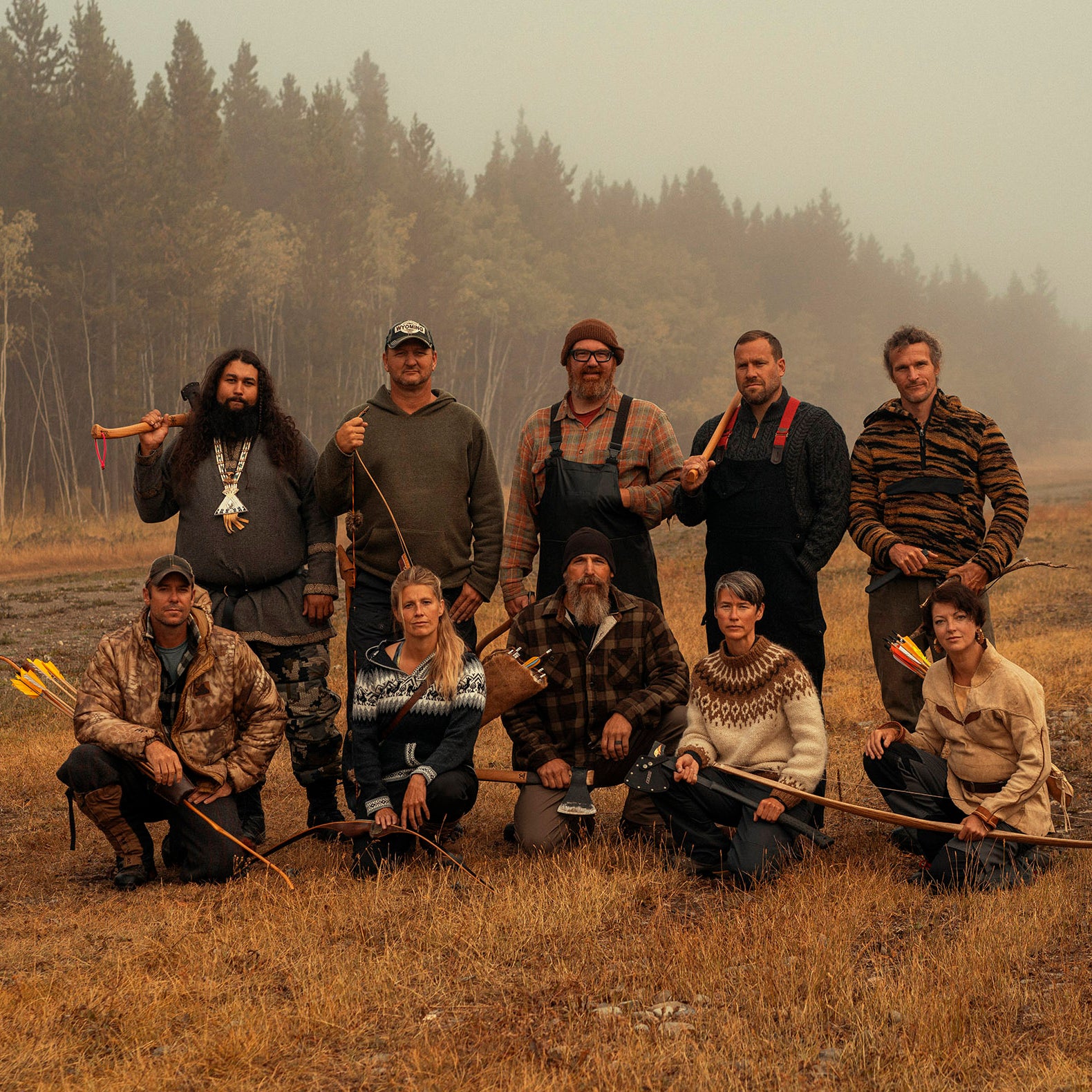When I found myself rigging up a tarp shelter in the dead of winter, I knew I had gotten in too deep. My partner, Lauren, stood beside me shivering as her headlamp illuminated my hands. It was a clear night with temperatures in the teens. I rushed to set up the ridgeline while I still had feeling in my fingers, then tightened it and threw a tarp over it. While I adjusted the shelter, a woman with an elegant parka and an even more elegant dog walked past us, gawking and perplexed.
I live in downtown Toronto.
Over the past year, I’d launched headlong into survivalism, purchasing a six-inch bushcraft knife (Scandinavian grind), a ferro rod, and all the cordage one could ever need. It all started when I began watching during the pandemic. The show has been a mainstay of the History Channel since its 2015 debut, and its popularity skyrocketed during the COVID-19 shutdowns.
The premise of the show is simple: Ten contestants are scattered across a remote section of wilderness, each with ten approved items in tow. The contestants must then try to make a home amid the discomfort of their new environment by building a shelter, hunting food, and staving off predators. As days turn into weeks, they struggle to find enough to eat. Their bodies begin to atrophy from malnourishment, and daily tasks like getting water or checking traps become much more of a struggle. The last person remaining wins $500,000.
As I consumed one episode after another, season after season, I realized that my obsession with the show was not unique. Several streaming services, including Netflix, have picked up the show, and recently actor “kind of a brilliant pandemic show.” According to Google Trends, worldwide searches for “Alone show” peaked in June 2020.
The experience of watching Alone during a pandemic, particularly in a COVID-19 hotspot, was an unusual one. Many viewers, including me, seemed to be searching for something deeper while watching the show: a roadmap for navigating the loneliness and hardship of an unprecedented moment.
Ahead of the eighth season of the series, airing this summer on the History Channel, I decided to call up some of the show’s current and former contestants to learn how they managed isolation in the wild and reintroduction to normal life after leaving the wilderness. I thought their experiences of fear, loneliness, and anxiety might help me better navigate the many challenges of this pandemic.
The first person I talked to was , a contestant on the current season of Alone, who has followed the show since the beginning. Wright, an Oregonian who sings in a metal band and attends Renaissance festivals learned his outdoor survival skills from his father, a marine veteran who was an avid hunter and fisher. He studied past contestants‚Äô strategies but is no expert. ‚ÄúI‚Äôm just a random guy,‚Äù Wright says.¬Ý ‚ÄúI‚Äôm not a survival skills instructor or anything like that. I just have outdoor skills, and I love it, and I live it.‚Äù
The eighth season takes place in Chilko Lake, British Columbia, where contestants face the threat of grizzly bears and mountain lions on top of bone-chilling cold, isolation, and food scarcity. Wright dealt with the loneliness by keeping his mind busy. “If I didn’t have tasks, then I was keeping my mind in the game by singing songs and just making jokes to myself,” he says. Wright approached the show in much the same way that he approaches daily life—with ease. “I went out there humble, ready to get my ass kicked for sure,” he says. “I was going to try and focus my efforts on fishing, trapping, and foraging for plants because those are my strengths…I’ve never hunted big game with a bow.”
Wright’s experience testing his mental and physical limits through isolation became a reality for so many people when the pandemic hit. In Toronto, the most populous city in Canada and a COVID-19 hotspot, the loneliness was dire. Over the past 16 months, the city has undergone a series of shutdowns. Many aspects of daily life—walking down the street, buying groceries, taking public transit—became terrifying endeavors. It was in the thick of this terror that I joined people around the world in turning to the show. My initial interest stemmed from a deep fascination: Why would someone do this to themself? What kinds of challenges would they face? Mesmerized, I watched the first season over a three-day period. After that, I watched another season, and then another, and yet another.

In season three, I found myself inspired by , a fan favorite who excelled in the harsh conditions of Patagonia. During her 72 days, she built a home, then moved on to construct a chair for herself, a makeshift sauna, and finally a wind chime.
I called up North, who lives in a small community in Washington’s San Juan Islands. She and her partner, Randy Champagne, also a contestant on the show (seasons two and five), live off the grid and are expecting their first child. North says that both she and Champagne experienced “a huge burst” of fans reaching out to them at the beginning of the pandemic.
She can see parallels between her time on the show and being in COVID-19 shutdown. “So many of us felt that if we looked ahead, time seemed to stretch out forever,” she tells me. “But if you were present in your situation, you can understand just how quickly time is actually moving and how this experience will pass—and it’s not just the hardship of this experience that will pass, but also the joys of this experience.”
North’s building projects are what got her through both the wilderness and the pandemic. Having a creative practice has sustained her through all sorts of challenges, she says. “I think that creativity really relates to ingenuity and critical thinking. And there’s no better time for that than this pandemic.”
Watching at home, trapped inside a 450-square-foot apartment with my fiancée and our cat, I got a similar idea for a path forward: bushcraft. I wanted a challenge that was labor-intensive and required regular practice. I also needed an excuse to leave my apartment in search of less traveled corners of the city. That’s how I found myself putting up a tarp shelter in downtown Toronto and, later, beginning the long and arduous process of making a gill net. I was now going headlong into the world of bushcraft and survivalism.
I struggled to return to whatever we called “normal” before the pandemic. What is normal when you’ve spent a year and a half in isolation playing with ferro rods and practicing knots?
Of course, another reality of the pandemic was serious illness and death, which Alone contestants gain lots of experience confronting. In addition to dealing with hunger and loneliness, North suffered bites from a Chilean recluse spider, which eventually became infected and threatened her time on the show. It was an eye-opening experience. Alone taught North to ask questions like “What are the lessons that we’re taking out of this?” she says. “How can we be present, understanding that this is a moment in our lives that will be over very quickly, and not being so wrapped up in ‘This is forever. This is my new reality. I’m never going to be able to get out of this.’ How can I embrace it? What can I do to support my community, both near and far, support my family, support myself and my own health, and understand that this moment will pass?”
In February 2021, a close friend of mine got COVID-19, then another, and another. Then a family member contracted COVID-19 and was put on a ventilator. From the same couch where I had watched contestants hunt grouse, build boats, cry, starve, and long for home, a nurse now spoke to me on a tablet. She carried it into the room to show me my family member fully intubated. I spent my days sending updates to family and friends and helping loved ones navigate the technical and emotional challenges of tele-grieving at a time when in-person visits were impossible.
Wright was even more cut off from loved ones while on the show during the pandemic. He had to leave his fiancée, who was expecting twins. “She was really going through her own Alone challenge back home, and that really tore me up while I was out there,” he says. “We both said that whenever the moon was high, we’d look at the moon and know that we’re both looking at the same moon. Those kinds of things really helped connect me to home even though I was so far away.”
I was also curious what the return home was like for Alone contestants. When North left the show to head back to Washington, “the difficulty was very unexpected,” she says. “I think I had a sense that I would just hit the ground running when I came home and be able to just integrate all the work and bring back all this new wisdom. But the physical recovery alone took years, really. That initial phase was incredibly challenging.”
North notes that at the end of season three, contestants did not have any support from Alone staff with nutrition or food integration after they left the show. As a result, adjusting back to normal life was difficult. “There was a lot of body trauma that came out of that, and the emotional integration of that work was much bigger than I could have ever anticipated. That first year was really, really intense.”
Miraculously, my family member survived and began to recover. By May, Toronto, too, appeared to be in recovery. The caution tape was removed from the playgrounds, and children could once again be heard laughing and playing. The patios began to buzz.
I, however, did not feel such relief or elation. I struggled to return to whatever we called “normal” before the pandemic. What is normal when you’ve spent a year and a half in isolation playing with ferro rods and practicing knots? I’m now worried that returning to normal life might not be possible: that grocery stores, crowded bars, and fleeting conversations with strangers may never feel safe again.
My newfound social anxiety and the growing number of variants hang heavy over the places I once frequented; I’m not sure when I’ll be able to adjust to post-pandemic life. But to my loved ones so close and yet so far away, know that when the moon is high, we are looking at the same moon. Eventually this too shall pass.
In the meantime, I have a new season to watch and a gill net to finish.
Alone on the History Channel.


